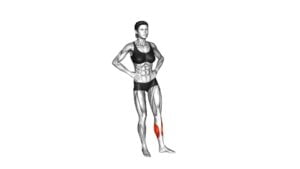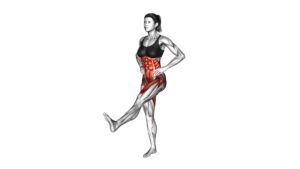Standing Balance Hip Rotation (female) – Video Exercise Guide & Tips

Are you looking to improve your balance and strengthen your hip muscles?
Watch This Exercise Video
In this video exercise guide, you will learn how to perform standing balance hip rotation.
This exercise is specifically designed for females and aims to target the hip muscles while improving stability.
With proper form and technique, you can maximize the effectiveness of this exercise.
Whether you're a beginner or advanced fitness enthusiast, there are modifications and progressions available for all fitness levels.
Get ready to challenge yourself and achieve better balance and hip strength.
Key Takeaways
- Standing balance hip rotation helps prevent injuries and strengthens the hip and core muscles.
- It mimics real-life movements, improving overall body resilience.
- It enhances stability, coordination, and proprioception.
- It allows for greater control and confidence in daily activities, sports, and exercises.
Benefits of Standing Balance Hip Rotation
To maximize the effectiveness of your standing balance hip rotation exercise, it's essential to understand the numerous benefits it offers.
Incorporating this exercise into your fitness routine can greatly contribute to injury prevention and improved stability.
One of the key benefits of standing balance hip rotation is its ability to prevent injuries. By engaging the muscles around your hips and core, this exercise helps to strengthen and stabilize these areas, reducing the risk of strains, sprains, and imbalances.
Additionally, the controlled rotation of your hips in a standing position mimics real-life movements, making it a functional exercise that can improve your body's overall resilience.
Another advantage of standing balance hip rotation is the improved stability it provides. As you rotate your hips, you challenge your body's balance and coordination, forcing your muscles to work together to maintain stability. This not only strengthens your muscles but also enhances your proprioception, which is your body's awareness of its position in space.
With improved stability, you'll find it easier to perform daily activities, sports, and exercises with greater control and confidence.
Incorporating standing balance hip rotation into your fitness routine can be a valuable addition. Not only does it contribute to injury prevention, but it also enhances your stability, allowing you to move more efficiently and effectively in all aspects of your life.
Equipment Needed for the Exercise
You will need a stability ball for the standing balance hip rotation exercise. This equipment is essential for maintaining balance and stability throughout the exercise. The stability ball provides an unstable surface, which engages your core muscles and challenges your balance. It also allows for a wider range of motion during the hip rotation, enhancing the effectiveness of the exercise.
When it comes to exercise modifications, you can adjust the difficulty level by using different sizes of stability balls. If you're a beginner or have limited balance, starting with a larger stability ball can provide more stability and support. As you progress and become more comfortable with the exercise, you can switch to a smaller stability ball to increase the challenge.
It's important to be aware of some common mistakes and how to avoid them. One common mistake is using excessive momentum to rotate the hips. Instead, focus on controlled and deliberate movements to engage the targeted muscles effectively. Another mistake is leaning forward or backward, which can compromise your balance and strain your lower back. Make sure to maintain an upright posture throughout the exercise to avoid any unnecessary strain or injury.
Proper Form and Technique for Standing Balance Hip Rotation
Maintaining proper form and technique is crucial for performing the standing balance hip rotation exercise effectively, as it ensures engagement of the targeted muscles and reduces the risk of strain or injury. Here are some tips to help you maintain proper form and technique during this exercise:
- Stand tall with your feet hip-width apart and your core engaged.
- Keep your shoulders relaxed and your back straight throughout the movement.
- Slowly lift one foot off the ground while maintaining your balance on the other foot.
- Begin rotating your lifted leg out to the side, keeping your knee straight and your foot flexed.
- Return your leg to the starting position and repeat the movement on the other side.
Common mistakes to avoid during the standing balance hip rotation exercise include:
- Allowing your standing leg to collapse inward.
- Hunching your shoulders or arching your back.
- Using momentum to rotate your leg instead of engaging your hip muscles.
Variations and alternatives for the standing balance hip rotation exercise include:
- Performing the exercise while holding onto a stable surface for support.
- Using a resistance band around your ankles to add resistance to the movement.
- Performing the exercise on a balance board to further challenge your stability.
Modifications and Progressions for All Fitness Levels
As you progress through your fitness journey, modifications and progressions can be made to the standing balance hip rotation exercise to cater to all levels of fitness. Whether you're a beginner or an advanced fitness enthusiast, there are ways to adapt this exercise to suit your needs and abilities.
For beginners, it's important to focus on mastering the basic movement before adding any modifications. Start by performing the standing balance hip rotation exercise without any additional weights or equipment. This will help you build stability and strength in your core and lower body.
Once you feel comfortable with the basic movement, you can start incorporating modifications to challenge yourself further. One modification is to hold a lightweight dumbbell or kettlebell in your hand while performing the exercise. This added resistance will increase the difficulty and engage your muscles in a different way.
For more advanced fitness levels, you can further progress the exercise by increasing the weight of the dumbbell or kettlebell. This will intensify the workout and help you continue to build strength and stability in your hips and core.
By making these modifications and progressions to the standing balance hip rotation exercise, you can continue to challenge yourself and improve your fitness level.
Now, let's move on to the next section where we'll discuss some tips for maximizing the effectiveness of this exercise.
Tips for Maximizing the Effectiveness of Standing Balance Hip Rotation
To get the most out of the Standing Balance Hip Rotation exercise, try incorporating these tips to enhance its effectiveness:
- Maintain proper alignment: Stand tall with your feet hip-width apart and your knees slightly bent. Keep your core engaged and your shoulders relaxed. This will help maximize balance and stability while performing the hip rotation.
- Control your movements: Slow and controlled movements are key to maximizing the effectiveness of this exercise. Avoid swinging your leg or rushing through the rotation. Focus on engaging your hip muscles and maintaining control throughout the entire range of motion.
- Gradually increase the difficulty: Once you have mastered the basic form of the exercise, you can challenge yourself by adding resistance. You can use a resistance band around your thighs or hold a dumbbell or kettlebell in your hands to increase the intensity.
- Incorporate hip rotation techniques: To further enhance the effectiveness of this exercise, you can experiment with different hip rotation techniques. For example, you can try rotating your hip inward or outward during the exercise to target different muscles in your hip joint.
Frequently Asked Questions
How Long Should I Hold Each Rotation During the Standing Balance Hip Rotation Exercise?
When doing the standing balance hip rotation exercise, it's important to know how long to hold each rotation. The duration can vary depending on your fitness level and goals.
Generally, it's recommended to hold each rotation for about 5-10 seconds. This allows enough time to engage your core and improve balance. However, you can always adjust the duration to challenge yourself more or make it easier.
Remember to listen to your body and gradually increase the time as you get stronger.
Can I Do the Standing Balance Hip Rotation Exercise if I Have a Knee Injury?
Yes, you can modify the standing balance hip rotation exercise if you have a knee injury.
It's important to prioritize your safety and avoid putting excessive strain on your knee.
Consult with a healthcare professional or a physical therapist who can provide alternative exercises that are suitable for knee injury rehabilitation.
They can also offer tips on how to modify exercises to accommodate your knee injury and ensure that you're exercising in a safe and effective manner.
Is It Normal to Feel a Stretch in the Hip During the Exercise?
Feeling a stretch in the hip during the exercise is normal. It's a sign that you're engaging the muscles properly.
To perform the standing balance hip rotation exercise effectively, focus on maintaining proper form and technique. Keep your core engaged, stand tall, and rotate your hips smoothly.
If you want to target different muscles, there are modifications and variations available.
Remember to always listen to your body and consult with a professional if you have any concerns or injuries.
Can I Perform the Standing Balance Hip Rotation Exercise on a Yoga Mat?
Yes, you can perform the standing balance hip rotation exercise on a yoga mat. Using a yoga mat provides several benefits, such as cushioning and stability. It can help prevent slipping and provide a comfortable surface for your workout.
However, if you don't have a yoga mat, there are alternative exercise options. You can perform the exercise on a non-slippery surface or use a towel or blanket to provide some cushioning. Just make sure you have enough space to move freely.
How Often Should I Incorporate the Standing Balance Hip Rotation Exercise Into My Fitness Routine?
To get the most out of your fitness routine, it's important to know how often to incorporate the standing balance hip rotation exercise.
This exercise offers numerous benefits, including improving balance, hip mobility, and core strength.
As for sets and reps, start with 2-3 sets of 10-12 reps on each side. As you progress, you can increase the number of sets or reps.
Remember to listen to your body and adjust as needed.
Conclusion
In conclusion, standing balance hip rotation is a highly effective exercise for improving balance, stability, and hip mobility in females.
By engaging the core muscles and focusing on proper form and technique, this exercise can help prevent injuries and enhance overall fitness.
With modifications and progressions available for all fitness levels, individuals can gradually increase the difficulty and intensity of the exercise.
By following the tips provided, individuals can maximize the effectiveness of standing balance hip rotation and achieve their fitness goals.

Author
Years ago, the spark of my life’s passion ignited in my mind the moment I stepped into the local gym for the first time. The inaugural bead of perspiration, the initial endeavor, the very first surge of endorphins, and a sense of pride that washed over me post-workout marked the beginning of my deep-seated interest in strength sports, fitness, and sports nutrition. This very curiosity blossomed rapidly into a profound fascination, propelling me to earn a Master’s degree in Physical Education from the Academy of Physical Education in Krakow, followed by a Sports Manager diploma from the Jagiellonian University. My journey of growth led me to gain more specialized qualifications, such as being a certified personal trainer with a focus on sports dietetics, a lifeguard, and an instructor for wellness and corrective gymnastics. Theoretical knowledge paired seamlessly with practical experience, reinforcing my belief that the transformation of individuals under my guidance was also a reflection of my personal growth. This belief holds true even today. Each day, I strive to push the boundaries and explore new realms. These realms gently elevate me to greater heights. The unique combination of passion for my field and the continuous quest for growth fuels my drive to break new ground.







